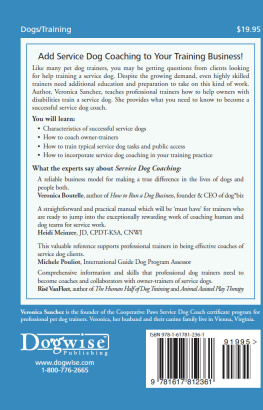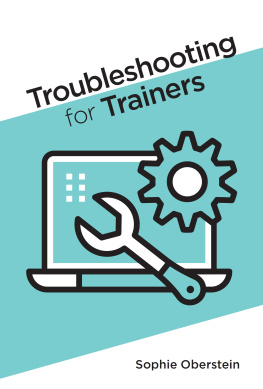Whether you train, manage trainers or are merely interested in the topic, this little guide offers plenty of useful information. Geri E. McArdle not only helps you understand the importance of training and what it takes to train well, she also provides a 20-step model to guide you in creating your own first-rate development program. The steps take you through six crucial areas of training, from determining if training can actually solve a problem to developing, delivering and assessing your sessions. You can use McArdles model as a checklist for ensuring that your learning programs dont lack a crucial ingredient. Her concise book, packed with handy advice as well as useful tables and diagrams, is especially effective in defining trainers responsibilities. However, this guides breadth of knowledge far exceeds its depth. You may have to turn to other training resources for detailed information about a specific topic. getAbstract recommends this as an introductory guide to all that good training requires.
Summary
Why Is Training Important?
Employees must continue to learn and advance to have a viable career in a modern corporation. As technology changes and organizations adapt and grow, work responsibilities will evolve. A companys training programs should be equally dynamic. They should address its current training need, whether that is teaching new skills, helping employees explore and select a work path, enhancing teams effectiveness, or increasing overall productivity.
Learners demand easy-to-use materials, with content that focuses on direct application to the job.
Many forward-thinking trainers are creating programs that not only impart specific knowledge, but also help people cope with change. These trainers teach relevant and up-to-date techniques and offer insights into possible future trends. They show professionals what they can do to stay ahead in the rapidly changing marketplace.
Approaches to Training
People want learning to be an interaction. They rarely tolerate a trainer who lectures at them. Consider your content and the program structure. Do you focus on practical job-related applications rather than on theory? Is your course clear and modular? Do you offer easy-to-use materials that include graphics? Will your handouts be helpful to people when they return to work?
Through training, individuals can learn how to accept responsibility for their own shortcomings and developmental needs in order to manage their careers wisely.
Trainers should be gifted teachers as well as subject experts. This involves being sensitive to the different ways people learn, including visual, auditory and kinesthetic modes. As you interact with your participants, identify how they take in information. Are they global processors who need to know the big picture right away, or are they analytic processors who first want to understand the details? Adapt your role to class members preferences.
Although there is no one comprehensive learning style theory that all researchers and trainers agree upon, they do agree that individuals learn differently.
Training does not have to be anchored in a classroom. Some courses have moved outdoors to teach team building and leadership. Training via computers and networks is also growing increasingly popular. It offers opportunities to tailor education to individuals needs. People can learn at a time convenient to them and repeat lessons as necessary.
Trainer Credibility
Aristotle said, Three things inspire confidence in character...good sense, good moral character and good will. Keep these qualities in mind as you try to build credibility as a trainer. Carefully manage all aspects of your training program, including your role as the class leader, your body language, the way you use the classroom space, and your voice. Heed the 10 rules of a leader:
- Control the agenda and dont wander from it.
- Have course goals and teach to accomplish them.
- Be fair and respectful toward those you train.
- Listen to people, so you know if they understand the material.
- Periodically review the information youve covered.
- Encourage people to make connections while summarizing important points.
- Hold your classs attention. Help people focus on the lesson.
- Always maintain your authority.
- Find a way to engage quiet or uninvolved participants.
- Offer clear direction.
Trainers should teach what they know and know what they teach. They should be confident, organized and well-prepared.
Being credible and having authority involves managing questions well. Do not allow off-topic questions to distract you or the class, but provide clear, direct answers to relevant ones. Use a five-step process to respond effectively: 1) listen, 2) acknowledge the question, 3) ask for clarification, 4) answer the question and 5) verify that your answer is acceptable. If you dont know the answer, dont risk responding to it. Simply say that you will return to the question once you have had time to do some research.
The purpose of establishing a training system in an organization is to ensure you design programs that respond to the organizations business needs, are educationally sound and have measurable product learning.
Be aware of how you use space in your training sessions. People have personal boundaries that vary by culture. Most consider the area within a foot (approximately 30 centimeters) or two of their bodies as intimate. Normal communication takes place within two to five feet, and formal communication beyond 12 feet. If you are leading a formal training course, avoid coming nearer than 12 feet. You could make people uncomfortable. However, if your program is more casual, you can interact closely with participants, walking among them and sitting in their groups.
People can learn leadership by using others as role models and by attending effective training programs.
Communicate your confidence and honesty through nonverbal and verbal signals. Dress in a way that indicates authority but is also inviting. Maintain good eye contact with your participants. Do not zoom in on just a few individuals or on one side of the room. If you are anxious or bored, avoid letting your face betray those feelings. How you use your voice also has an impact. Be sure you are heard, but do not shout. Dont undermine yourself by apologizing, making weak jokes or talking off topic. Enunciate clearly while maintaining a comfortable speaking pace.











